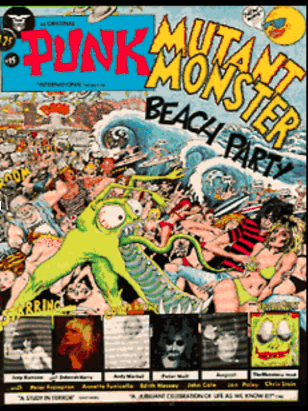
The PUNK magazine, with its quirky, sardonic style, paired with a DIY aesthetic with brash cynicism is arguably the pinnacle of 70s New York City punk graphics. From the very first issue, the magazine embodied its unique style while providing essential early coverage of punk artists like Ramones, Patti Smith, Sex Pistols, and Blondie. Articles about bands alternated with cartoons, references to TV culture, and features bristling with rebellious teen attitude represented one of the first forms of public writing that expresses early punk culture quite literally. The magazine gives its reader a taste of punk rock subculture that appropriated everyday elements, shifting goods from their original meaning, giving new meaning and inventing an unconventional lifestyle. Thus, Punk fanzine operated as a medium of communication and propagation for punk fans and in the late 70s Downtown New York City through its symbol of defiance and producing its own means of graphic language.
PUNK magazine appeared in 1975 to give rise to a unified identify. The magazine zeroed in one the CBGB’s crowd and became an intrinsic element to New York’s subterranean music scene. According to Holmstrom, the author of Punk Magazine, the name “Punk” was originally chosen for its shock potential: “Punk was dirty word at the time. Us putting Punk on the cover was like putting the word ‘fuck’ on the cover.” The magazine was packed with satirical stories and snippets, goofy cartoons and spoofs of teen-mag photo strips, the latter culminating in PUNK’s “Monster Beach Party” issue, starring Joey Ramone, Debbie Harry and a retinue of figures from the New York punk circuit. In the “Mutant Monster Beach Party” issue, the plot presents the character Debbie, who choose to oppose her sheriff father for her long-haired, unconventional punk boyfriend Joey, depicts a symbolic expression of a culture in challenging and denying of all that was part of the mainstream. Humorously, the issue concludes by the portrayal of naked group violence at a beach setting demonstrating another expression of un-conventionalism to the mainstream society. From this, it can be argued that PUNK became one of the early artists’ many symbols of defiance. Punk activists at the time attempted to collectively construct a culture that encompassed ideologies and philosophies of personal freedom, anti-capitalism and animals rights amongst many others. The PUNK magazines having hinted these ideologies in its issues, were presented to the public as a direct challenge to the politics of a mainstream society.
PUNK is also a type of fanzine that distinguishes from typical magazines because much of its content is submitted by amateur writers, with readers’ letters and discussion columns providing a crucial mechanism for interaction between readers. Fanzines remained the primary form of communication amongst punks into the twenty-first century, propagating the ideas which define ‘punk culture and philosophy’ such as sex-related issues, music, environmental philosophies, and the politics of punk business. Fanzine, therefore, became vehicles of subcultural communication and played a fundamental role in the construction of punk identify and a political community.
PUNK fanzine was meant from the start to be a comical genre of irreverence and absurdity. By choosing the medium of comics, early punk artists believed it provide crude vitality and immediacy of communication that excluded from the mainstream of cultural life, an ideal medium for expression of punk ideas. The interview with Lou Reed in PUNK’s first issue, which Holmstrom choose wrote up partly in hand-lettered text and partly as a cartoon strip, with some photos was the earliest depiction of using comic medium. Consequently, a mix of music genres and comic strips and similar cover drawings remained a strong part of PUNK’s look to the end. To the punks, the crude and amateurish drawing of comic strips is a convenient and simple way of expressing their punk authenticity. PUNK demonstrated a practice of cultural work because is used the same low-value production techniques that characterizes early fanzines. Photocopying, random note cut-outs, badly handwritten, typewritten texts, and collage images, all characterize the early punks’ use of its own subcultural graphic language. It is the low-tech cut-and-paste production of fanzines, the passion and effort involved in producing fanzines, which gave them their essence of authenticity. In particular this DIY practice is central to the ethos of punk. It is through this editorial content, rather than the design, that the shared punk values, ideologies and philosophy of the early New York punk movement are disseminated amongst the fanzine readership. And it is through this activity that the fanzine is constructed as a site for defining identity, ideology, defiance and opposition of the mainstream society.
PUNK Fanzines has became the vehicles of subcultural communication and played a fundamental role in the construction of punk identity and a political community. The PUNK magazine is a cultural work, having been responsible for the spread of ideas, bands, important concerts and event schedules. Artist like Patti Smith takes a part in the magazine to express freely their ideal of punk art and music.